Table of contents
- Focus on alternative drives Hybrid and electric motors
- The oil reserves are limited
- The capacity problems of today’s batteries
- Other problem areas
- Racing with electric motors
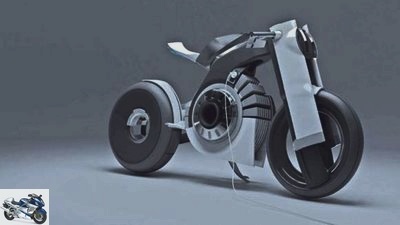
motorcycles
Focus on alternative drives
Focus on alternative drives
Hybrid and electric motors
If we talk today about what will move us tomorrow, it is important to remove the fetters of the present. “Dare the future”, is the motto? without which we wouldn’t be where we are. Under the umbrella term “alternative drives” would like to encourage MOTORRAD to think further.
Peter Mayer, Monika Schulz
December 18, 2008
First steps are always the hardest ?? even when it comes to driving. This is true now that we can hardly deny the evanescence of the internal combustion engine world, just as it did at the time when it was invented. Gottlieb Daimler’s riding car, according to the Imperial Patent Office on August 29, 1885 as “Vehicle with gas or petroleum engine (…) patented in the German Empire”, managed almost three kilometers on its maiden voyage. It went from Cannstatt to Unterturkheim in the Stuttgart area. Not far enough to overtake a horse. The first long-distance journey ?? and with it the breakthrough of the automobile? only succeeded three years later.
It is August 5, 1888: Karl Benz has his 0.8 hp “Motor car no.1” had it patented 20 months ago, but doesn’t trust it. His own invention seems too unreliable to him. The public trusts the vehicle even less than mocks it “Carriage without horses” and does not show the slightest interest in buying. Karl struggles with self-doubt, while Bertha Benz starts an advertising tour from Mannheim to Pforzheim without her husband’s knowledge. Over 100 kilometers! Also part of the party: her two sons ?? sometimes screwing, sometimes pushing, always plunging to pharmacies, where ligroin (cleaning spirit) is traded, even if only in homeopathic doses. There are of course no gas stations yet, and Papa’s Benz swallows more than expected. The combo is not discouraged, however. The overland trip succeeds, whereupon the patent is recognized as a complete replacement for horse and cart and celebrated at the Paris World Exhibition.
Anyone who follows in Bertha’s footsteps with an electric motorcycle 120 years later is again faced with the question: Where do I pull the material that will get me ahead if the charged capacity is insufficient? And this is exactly where it comes to the fore with some: insufficient range, too high a procurement effort? e-mobility is now done for these people. But do it. Germany’s first street gas pump was only planted in 1923, until then refueling remained a rather complicated and extremely dangerous thing. And who cares today? Who remembers when in the “Mega fuel boutique” the EC cards are drawn out? Not even the gas station attendant, because it actually doesn’t exist anymore.
The world has changed rapidly, why should it stop at the development of alternative drives? So we give the pioneering spirits a little more time, think with every study, every attempt at Daimler’s strange riding car, which also didn’t look like it would one day dash plastic-clad with 300 things over six-lane motorways. Viewed in this way, the Honda Oree shown on the left doesn’t seem far-fetched. Niko Albertus and Andre Look, students at the Hochschule fur Gestaltung in Offenbach, presented the design at Intermot 2008. The 70-kilowatt electric motor and everything that goes around it are still a long way off, but the echoes are convincing. We have compiled the alternatives to the Otto motorcycle that can already be used on the following pages.
The oil reserves are limited
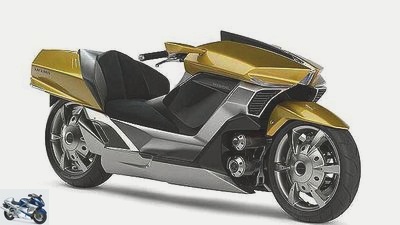
Yamaha Hybrid Study – Luxair Gold.
One number is enough: 13 billion liters. That is the amount of oil that mankind uses every day. To put it more clearly: Filled in tankers and lined up in a row, the resulting line of trucks would stretch from Marseille to the North Cape and back. As I said, every day. In this respect, neither the CO2 discussion nor the scenario of horrific increases in fuel prices in the medium term is needed to distract from the fundamental insight that simply means: at some point it will end.
And that’s not that long ago. A study by the mineral oil company BP estimates the remaining service life of the currently known oil wells at around 40 years. More optimistic forecasts assume that the remaining term will be around twice as long, but warn of exorbitant increases in production costs due to the increasingly difficult oil fields to exploit.
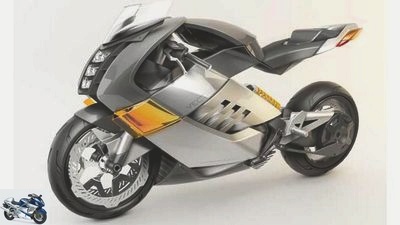
Vectrix SBK study – 50 kW output, 200 kilometers range.
What remains? Consume less and develop alternative drive concepts that are as independent of the oil as possible. Not an easy task, because in the end, gasoline has given a decisive property the triumphant advance: the energy density. Twelve kilowatt hours (kWh) are stored in a single kilogram (1.35 liters) of gasoline. Almost twice as much as in coal or in alcohols like methanol. On top of that, gasoline is relatively cheap to produce, easy to distribute and easy to deposit in a vehicle. Qualities that will give those future substitutes ?? be it electric, hybrid or fuel cell concepts (see info) ?? still has ahead.
Nevertheless, it currently gives the impression that the electric drive, as the most promising young talent, is already warming up for a change. Especially spectacular reports from the automotive industry stir up interest. For example, the Mini Cooper E or the American sports car Tesla, with outputs of over 200 hp and a range of around 300 kilometers, bring the electrified drive form to the headlines. Of course, power generation also nibbles on resources. Renewable sources such as wind, solar power or hydropower currently only contribute one eighth of the total amount of electricity produced. After all: while an internal combustion engine converts 37 percent of the energy present in gasoline into propulsion at best, does a power plant work ?? operated with coal or oil for example? with an efficiency of around 50 percent.
The capacity problems of today’s batteries
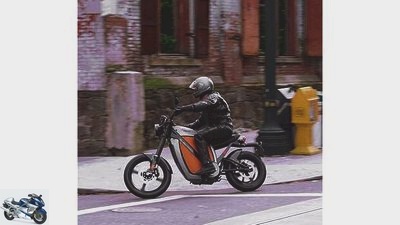
Enertia – 13kW power, 70 kilometers range. Price: around 9,000 euros.
All that needs to be solved is the problem of how to take this energy with you on tour. The current magic word: lithium-ion batteries. Only since these batteries, which are also used in cell phones, were adapted for mobile use, has it been possible to store larger amounts of energy in the limited space of a vehicle? and thus to make it attractive for motorcycles. No wonder new studies or prototypes of electric vehicles appear almost every month. And: In addition to electric motorized commercial vehicles based on scooters and mopeds, projects are currently being developed in the motorcycle sector, even if small idealistic manufacturers are currently still plowing this field.
Quantya is one of them. Since this year, the Swiss manufacturer has been playing trendsetters with street-legal off-road e-bikes. The electric motor has an output of 12.6 kilowatts (17 hp) and the lithium-ion battery holds 2.5 kilowatt hours. According to MOTORRAD measurements (issue 23/2008), this is enough for 30 minutes at full throttle (top speed: 70 km / h) on the country road, and for an astonishing two hours on the enduro lap. Because the technical design has the character of a light motorcycle and the price is steep at 9600 euros, “the interest is huge, but only after a long hesitation is bought”, knows Hans Eder, Germany importer of Quantya. In absolute numbers: In the 2008 season, Bayer brought 120 e-enduros to the public. Nevertheless, the message makes sense: “No sound equals more ground” ?? less noise opens up more opportunities. This company motto changes the focus of the Stollen-Bikes: away from the noise instead of away from the oil. Indeed, the almost noiseless electric drive opens up new perspectives for off-road sport, which KTM has recently been targeting with a study similar to the Quantya. Off-road slopes in industrial areas or on local sports grounds are moving into the realm of feasibility ?? two Quantya parks equipped with rental machines in the Bavarian town of Siegsdorf and Munich demonstrate this.
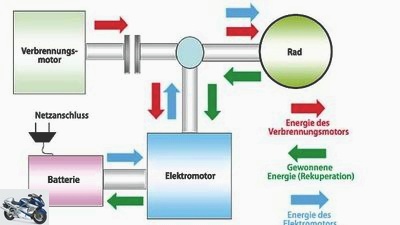
The hybrid concept tries to combine the best of both worlds.
The practical side of an electric drive is also fundamentally convincing. An electric motor does not need a clutch or manual transmission and is brilliant? quite in contrast to the internal combustion engine? with a maximum torque available almost from a standstill (see comparison of performance curves on page 23) Advantages that the second currently available electric concept, the Vectrix electric scooter, also has. At 9,000 euros, the Americans are also calling for a hefty price for the travel scooter, but are modest with a less powerful nickel-metal hydride battery. The large part under the running boards weighs 90 kilograms, while the wheel hub motor has an output of 18.7 kilowatts (25 hp). That is enough to take off the line of cars at every traffic light by means of the said acceleration force of the electric motor and then playfully swim along in the country road traffic.
And as with the Quantya, the world on the e-scooter is different. The almost silent gliding fundamentally changes the motorcycling experience. The missing sound? or noise? ?? relieves the senses, opens up for other impressions. As you drive through town, you can hear the do-it-yourselfer cursing in the garage or the music coming from the bend gardens. The perceived distance to the people outside the motorcycle saddle is reduced dramatically without the sound carpet. The MP3 player with four-stroke sound, which is secretly planned for future electric rides, quickly disappears from thoughts. Suddenly you think about the fact that electric bikes would never have been closed or motorcycles banned at night. It’s frightening how quickly being influences consciousness and degrades the internal combustion engine in the mind to an obsolete model? as long as you don’t look at the remaining distance display.
Other problem areas
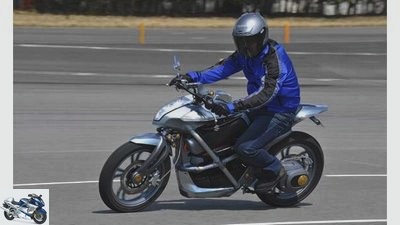
Suzuki study: the Crosscage achieves a top speed of 30 km / h with an output of 2.5 kW.
Because after about 50 kilometers is the Vectrix shift. Anyone who is not standing in front of their home garage by then needs a good-willed resident and three hours to charge. Reality comes to mind: a current lithium-ion battery can store just 0.12 kWh per kilogram. Little more than a hundredth of the energy content of a liter of fuel! The 25 kilo battery block (2.5 kWh) of the Quantya bunkers the energetic equivalent of a scant 0.3 liters of gasoline, the metal-hydride trumpet of the Vectrix only 0.45 liters.
However, the following must be taken into account: While an internal combustion engine uses the said 37 percent of the energy in gasoline at best, an electric motor works with over 90 percent efficiency. Mathematically, a quarter of a three-quarters of a liter of fuel becomes available, but this does not change the fact that every trip begins with the fuel tap on the reserve position.
And the forecasts are cautious. Experts assume that the energy density of batteries will increase by 25 percent by 2012, and will roughly double by 2018. That doesn’t sound like a technological breakthrough. There are also questions. Battery life? About 1000 charges. Recharge price? Around 1.50 euros for 100 kilometers. Reload time? Three hours. Battery prices? It is assumed that it will be around a third of today’s level (current price of the Quantya battery: 4,000 euros) in four years. Answers that, despite all the general enthusiasm, raise concerns that the electric drive will not be suitable for the Alpine tour in the foreseeable future. So it is not surprising that most electric concepts focus either on short-haul vehicles or on sport. On top of that, the number of current projects remains manageable, as the following overview shows.
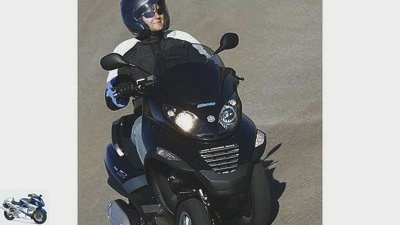
Piaggio hybrid scooter MP 3 HyS: combustion engine 11 kW, electric motor 2.5 kW. Price around 10,000 euros.
The American Enertia, for example, which is based on the Aprilia Moto 6.5. leans, does not create any new prospects with a 13 kilowatt (18 hp) engine, a range of 70 kilometers and a sales price of 9,000 euros. The Spanish Sun RED project is certainly not for shadow parkers. Photovoltaic elements that are folded up when driving are intended to charge the batteries when parked in the unfolded state. Series production: rather unlikely.
The power of the electric motor of the Berlin eRockit is called up via bicycle cranks. The more intensely you pedal, the more the eight kW motor switches on, driving the device up to a speed of 80 ?? to the outside world apparently driven by pure muscle power. The price for the show: utopian 28,900 euros.
The big sister of the Vectrix scooter, the Vectrix SBK, is said to have already had its first rollout. If the key data of the athlete with 59 kilowatts (80 hp), a top speed of 200 km / h and a range of up to 200 kilometers are correct, this project could set a milestone. However, MOTORRAD’s request for an appointment has so far been unsuccessful.
Racing with electric motors

Study: KTM-Crosser with 7 kW of power and a range of 40 kilometers.
Proven progress is being made with the power of electricity on the very own terrain of the internal combustion engine, drag racing. The dragster catapults itself with 500 HP generated from the power of 90 kilogram batteries “Killacycle” from 0 to 269 km / h in 7.89 seconds. Not an isolated case: In the USA there has long been an acceleration racing series reserved for electric vehicles.
But in order to break out of the narrow radius of action around the socket, the electric drive needs reinforcement. This is what hybrid technology offers, which simply combines the electric motor with an ordinary combustion engine. If the batteries for the electric motor run out, the gasoline-powered reciprocating engine takes over. On top of that, it charges the batteries again during use. Actually awesome. The horse’s foot: two motors cost more than one, the coupling requires complex control electronics and, above all: for two drive sources it is extremely tight in the motorcycle. The result: a low battery capacity and small internal combustion engines. Nevertheless, this concept has done the Italian Piaggio Group. In 2009, the three-wheeled MP3 HyS (see page 26) with a 125 cm³ internal combustion engine and electric motor will go into series production.
First driving impressions from MOTORRAD: The activated electric motor compensates for the typical starting weakness of the internal combustion engine when driving off and helps the 125cc drive to almost double the torque in the starting phase. While the improved performance is clearly noticeable, the reduced consumption ?? Piaggio proclaims the minimum consumption 1.7 liters per 100 kilometers ?? not yet be verified. And the purely electric locomotion, as it is discussed in Italy for some cities, is severely limited with a top speed of 30 km / h and a range of 20 kilometers. Overland or on the highway, a hybrid vehicle consumes only marginally less fuel than its colleague with a combustion engine. In terms of price, the hybrid concept doubles the basic tariff of the conventional MP3 from 5,000 euros to around double, the MP3 HyS costs around 10,000 euros. In this respect, it remains understandable that the rest of the motorcycle industry is holding back in hybrid development. Apart from the large scooter study Luxair from Yamaha there is radio silence.

“Killacycle” – 370 kW of power and a top speed of 269 km / h.
The Japanese discovered the fuel cell in two-wheel research over the past decade. Basically, vehicles with fuel cell technology are flawless electric vehicles ?? with the difference that the batteries are recharged by a fuel cell while driving. Their exhaust gas consists of harmless water vapor. Another brilliant idea. And again, reality dampens the euphoria. Because the inexhaustible occurrence of hydrogen can only be obtained with great expenditure of energy and then refueled and stored in the vehicle at ridiculously low temperatures (minus 253 degrees) or gigantic pressure (350 bar). In addition, a fuel cell that would, for example, keep the batteries of the almost 20 kW Vectrix scooter running while driving, currently costs well over 10,000 euros.
And so the study presented by Suzuki under the name Crosscage rather demonstrates how far this technology still is in vehicle construction. The fuel cell cannot supply more than the three kW (four hp) electric motor, which is limited to 40 km / h. The test vehicle is still miles behind the development status of the electric and hybrid concepts. The same applies to the fuel cell counterpart from Yamaha, the city vehicle FC-ME and the Honda scooter FC Stack. Given these modest basic data, the question of consumption is of little interest. For information: 115 grams of hydrogen per 100 kilometers ?? for the equivalent of currently three euros.
What remains? As before, the need to reduce dependency on oil in the medium term. Despite all its limitations, the electric drive has the best cards in this regard. Especially in a motorcycle? just think of wheel hub motors and more efficient use of the installation space for the battery? there isn’t much potential yet. Spectacular events such as the racing premiere of electrically powered motorcycles as part of the Tourist Trophy on the Isle of Man in June 2009 will also help to steer the electric drive out of the corner of the unemotional commercial vehicle. Nevertheless, the changing of the guard of the internal combustion engine will not come so quickly. Most of the oil can be saved with the current state of development if this good old companion is simply trained to drink manners. This is the task at hand for the major motorcycle manufacturers, who are reluctant to offer alternative drives, to demonstrate their innovative strength. But this is another story ?? one that will soon be in MOTORCYCLE.
Related articles
-
Aral counselor traffic & business Basics: alternative drives Basics: alternative drives What could drive us in the future Refueling was yesterday. And…
-
Zero and Polaris: partnership on electric drives
Polaris counselor traffic & business Zero and Polaris: partnership on electric drives Zero and Polaris Partnership for electric drives The Indian parent…
-
What actually drives: Fritz W. Egli
archive Sports & scene What actually drives: Fritz W. Egli What actually drives: Fritz W. Egli 20 questions to Fritz W. Egli “I am lying in the hospital…
-
What actually drives: Erich Wunderlich
archive Sports & scene What actually drives: Erich Wunderlich What actually drives: Erich Wunderlich 20 questions for Erich Wunderlich He is clearly the…
-
www.bilski-fotografie.de 10 pictures bilski-fotografie.de 1/10 Benelli 254 bilski-fotografie.de 2/10 Benelli 254 bilski-fotografie.de 3/10 It’s…
-
Delta-XE: Students build superbikes with electric drives
Electric superbike Twente 11 pictures Electric superbike Twente 1/11 As Team Electric Superbike Twente, Dutch students have put an electric superbike on…
-
Voxan’s electric world records: Max Biaggi drives 408 km / h
Voxan 6th pictures Voxan. 1/6 Voxan wants to break the world record with this bike. Voxan. 2/6 The bike is said to have 367 hp. Voxan. 3/6 The bike is…
-
MOTORCYCLE tour tip – Alternative Switzerland tour
Tour tips Exclusive motorcycle tours for children to follow Presented by Dirk Schafer to travel MOTORCYCLE tour tip – Alternative Switzerland tour…
-
Pitlane: PS rookie drives KTM Super Duke Battle
fact Sports & scene Motorsport Pitlane: PS rookie drives KTM Super Duke Battle Pitlane: PS rookie drives KTM Super Duke Battle Battle strollers Content…
-
Energica and Dell’Orto: partnership for electric drives
Energica Dellorto counselor technology & future Energica and Dell’Orto: partnership for electric drives Energica and Dell’Orto Partnership for electric…